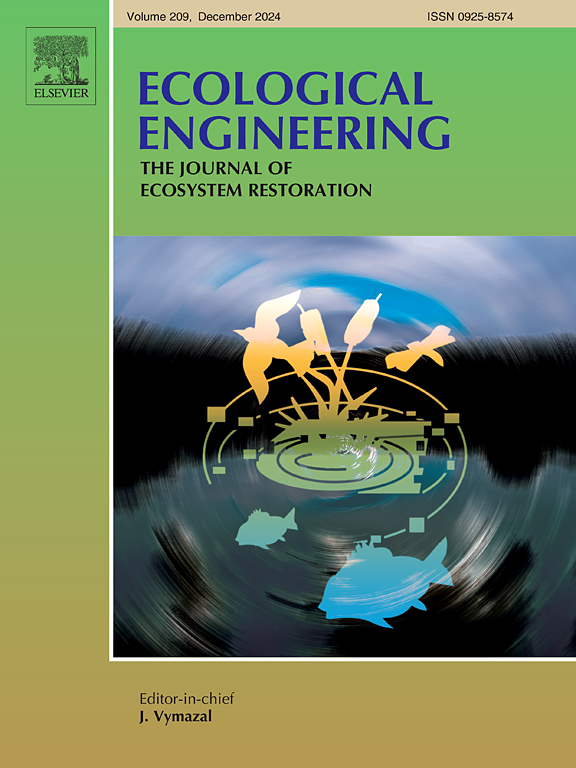Assessment of canal bank stability with vegetation root reinforcement
IF 3.9
2区 环境科学与生态学
Q1 ECOLOGY
引用次数: 0
Abstract
There is an increasing need for using nature based solutions in protecting canal and stream embankments in the Netherlands and delta areas in general. Vegetation provides additional reinforcement and forms an integral part of many nature-based solutions. However, quantifying this reinforcement in-situ is challenging. This study aims to quantify the root reinforcement of three species prevalent along canal embankments – Salix fragilis L. (SF), Salix purpurea L. (SP), and Crataegus laevigata DC. (CL) – using the corkscrew extraction technique. Furthermore, canal bank stability was analyzed under different bank conditions regarding protection (unprotected, protected by vegetation), bank geometry, and hydraulic conditions.
Quantity of roots and Root Area Ratio (RAR) generally decreased with depth for all species. While root breakage was observed in most samples, all species exhibited increased ductility with higher root densities, except for CL at two depths. SF showed higher root reinforcement at shallower depths (≤ 250 mm), while SP demonstrated greater reinforcement at deeper depths. Results demonstrate that the corkscrew extraction technique is a quick and minimally invasive method for measuring root reinforcement in riparian environments.
Bank stability simulations revealed that vegetation significantly increases the stability of canal banks. Notably, when considering measured root reinforcement, the factor of safety improved dramatically from 1.08 to 2.46, even under analyzed worst case conditions. However, the analysis suggests a limiting root reinforcement beyond which further increases in root reinforcement have minimal impact on stability. Monitoring using the corkscrew apparatus and future design approaches could aim to achieve this minimum reinforcement.
植被根加固对运河岸堤稳定性的评价
在荷兰和一般三角洲地区,越来越需要使用基于自然的解决方案来保护运河和河流堤防。植被提供了额外的加固,并形成了许多基于自然的解决方案的组成部分。然而,在现场量化这种强化是具有挑战性的。本研究旨在量化运河堤岸沿线常见的三种植物——脆弱柳(Salix fragilis L., SF)、紫柳(Salix purpurea L., SP)和克拉提乌(creataegus laevigata DC)的根系加固。(CL) -采用螺旋提取技术。此外,还分析了不同堤岸保护条件下(无保护、植被保护)、堤岸几何形状和水力条件下的运河堤岸稳定性。根系数量和根面积比(RAR)随深度的增加而减小。虽然在大多数样品中观察到根断裂,但除了两个深度的CL外,所有物种的延展性都随着根密度的增加而增加。SF在较浅深度(≤250 mm)表现出较高的根系加固,而SP在较深深度表现出较高的根系加固。结果表明,螺旋拔牙技术是一种快速、微创的测定河岸环境中根系强度的方法。河岸稳定性模拟结果表明,植被显著增加了运河河岸的稳定性。值得注意的是,当考虑实测根系加固时,即使在分析的最坏情况下,安全系数也从1.08显著提高到2.46。然而,分析表明,有一个限制的根系加固,超过这个限制,进一步增加根系加固对稳定性的影响最小。利用螺旋装置和未来的设计方法进行监测,可以达到这种最小的加固。
本文章由计算机程序翻译,如有差异,请以英文原文为准。
求助全文
约1分钟内获得全文
求助全文
来源期刊

Ecological Engineering
环境科学-工程:环境
CiteScore
8.00
自引率
5.30%
发文量
293
审稿时长
57 days
期刊介绍:
Ecological engineering has been defined as the design of ecosystems for the mutual benefit of humans and nature. The journal is meant for ecologists who, because of their research interests or occupation, are involved in designing, monitoring, or restoring ecosystems, and can serve as a bridge between ecologists and engineers.
Specific topics covered in the journal include: habitat reconstruction; ecotechnology; synthetic ecology; bioengineering; restoration ecology; ecology conservation; ecosystem rehabilitation; stream and river restoration; reclamation ecology; non-renewable resource conservation. Descriptions of specific applications of ecological engineering are acceptable only when situated within context of adding novelty to current research and emphasizing ecosystem restoration. We do not accept purely descriptive reports on ecosystem structures (such as vegetation surveys), purely physical assessment of materials that can be used for ecological restoration, small-model studies carried out in the laboratory or greenhouse with artificial (waste)water or crop studies, or case studies on conventional wastewater treatment and eutrophication that do not offer an ecosystem restoration approach within the paper.
 求助内容:
求助内容: 应助结果提醒方式:
应助结果提醒方式:


